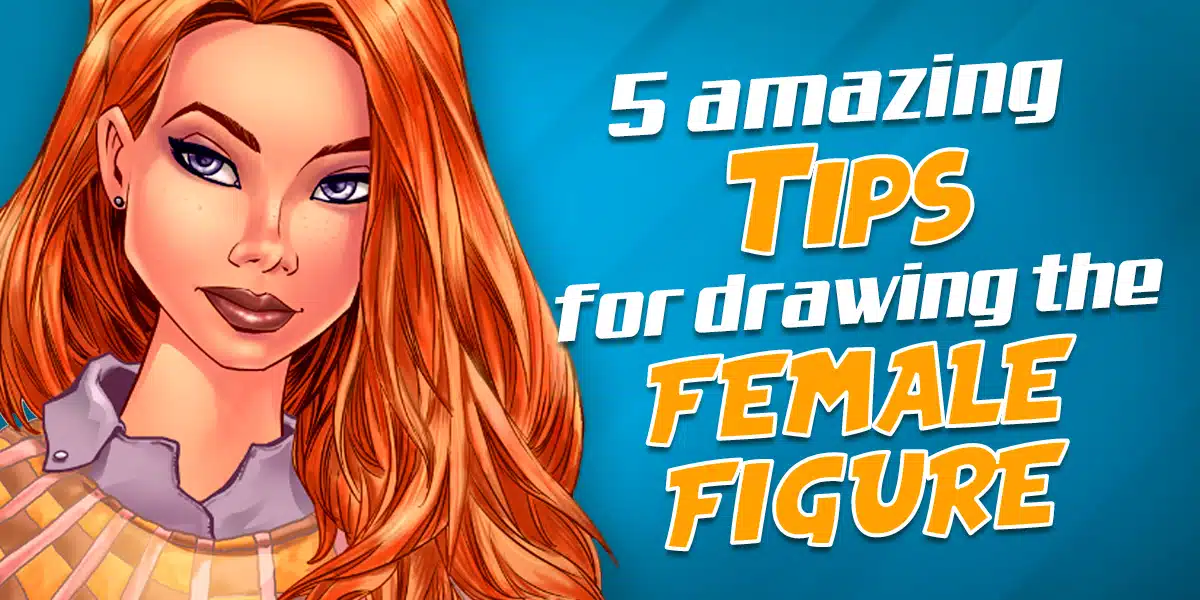5 fabulous tips for drawing the female figure: Master the art of anatomy
Have you ever wondered how to capture the essence of the female figure in your drawings? Have you faced the challenge of representing the delicacy and strength of a woman on paper? Get ready to immerse yourself in a fascinating journey through female anatomy and discover the secrets that will bring your illustrations to life. In this article, we’ll reveal 5 great tips for drawing the female figure, covering everything from the body in general to the subtlest details of the face, curves, arms, and legs.
The body canvas: Understanding proportions and diversity
As we delve into the world of the female figure, we encounter a universe of subtleties and proportions that require special attention. The keyword here is “curves”. A body with feminine features tends to present a more rounded silhouette, with hips generally wider than the shoulders. This characteristic is not only aesthetic but has biological roots related to motherhood.
However, it’s crucial to remember that not all female bodies conform to this stereotype. Diversity is the norm, not the exception. Some female bodies may have broader shoulders or a more angular structure, and that doesn’t make them less “feminine”. Regarding musculature, female bodies usually show a more subtle definition. Even in the case of female athletes or superheroes, the representation tends to maintain a certain softness in the forms.

A fundamental aspect to consider is the proportion between hips and shoulders. In most adult female bodies, the hips are wider than the shoulders. This detail can make the difference between a figure that is perceived as feminine and one that seems more masculine. Want to improve your skills in drawing proportions? Explore more here and discover resources designed to help you perfect your anatomical drawing technique.
Beyond stereotypes: The truth about breasts in art
When it comes to drawing the female figure, breasts are undoubtedly a distinctive feature. However, it’s crucial to approach this aspect with sensitivity and realism, avoiding falling into simplistic or exaggerated representations. The first tip may surprise you: when starting your drawing, consider the breasts as the last addition. Why? Because focusing too much on them from the beginning can lead to neglecting other equally important aspects of female anatomy.
Diversity is the rule when it comes to breasts. There are multiple shapes, sizes, and positions, each unique and natural. Some may be more spherical, others more triangular; some larger, others smaller. It’s also important to remember that areolas and nipples in female bodies are usually larger than in male bodies.
A crucial aspect that many novice artists overlook is the effect of gravity. Breasts are not simply spheres attached to the torso; they are complex structures composed of glandular and fatty tissue that respond to the body’s position. Their shape and position will change depending on whether the figure is standing, lying down, or with arms raised.

To truly capture the essence of the female figure, it’s fundamental to observe and study real anatomy. Click here to discover more about realistic female anatomy and access detailed guides that will help you represent breasts respectfully and convincingly in your drawings.
The power of the line: Mastering female arms and legs
When drawing female arms and legs, the key is to capture the characteristic softness and curves. Unlike male figures, which tend to show more pronounced angles, female limbs usually present more fluid and rounded contours. In the arms, seek to create smooth lines that flow from the shoulders to the wrists. Avoid marking the muscles too much, unless you’re drawing a specific athletic figure.
Female legs deserve special attention, as they are considered one of the most characteristic features of female beauty in many cultures. A distinctive characteristic is their proportionally greater length compared to male bodies. This is because, especially in youth, women tend to experience greater leg stretching.

When drawing legs, pay attention to the smooth curves of the thighs and calves. The transition between these areas should be fluid, avoiding too straight lines or pronounced angles. Remember that diversity is the norm: some legs will be more muscular, others thinner, but all can be equally feminine. Enter here to perfect the art of drawing female extremities and discover practical exercises designed to help you capture the essence of female anatomy in your illustrations.
The mirror of the soul: Deciphering the secrets of the female face
The face is perhaps the most challenging and rewarding aspect when drawing the female figure. It’s here where the personality and emotion of your character truly come to life. When approaching female faces, the key lies in the softness and subtle curves that characterize them.
Start with the general contour of the face. Female faces tend to be more rounded in the chin area, with less pronounced jaws than male ones. The superciliary arches (where the eyebrows are located) are usually softer and more curved. Cheekbones are a crucial element in the female facial structure. Depending on the physical build of the character, they can be more or less prominent.
Eyes and lips are fundamental elements that can make a difference in the expression of femininity. Female eyes are usually drawn larger and more expressive, with longer and more defined eyelashes. Lips, for their part, tend to be fuller and more defined than in male faces.

A common mistake is thinking that long hair is a requirement for a female face. While it’s true that long hair is culturally associated with femininity, basing the femininity of your drawing solely on this aspect can lead to faces that look masculine with long hair. It’s better to focus first on the facial structure and add hair as a complementary element, not a defining one.

To improve your skills in drawing female faces, Want to take your portraits to the next level? Discover advanced techniques here and access specific tutorials that will help you master every aspect of the female face, from the basic structure to the subtlest expressions.
Beyond stereotypes: Celebrating diversity in art
Throughout this article, we’ve explored various aspects of the female figure in drawing. However, it’s crucial to remember that these are just general guidelines and that reality is much richer and more diverse. The beauty of human anatomy lies in its infinite variety. There is no single “feminine” or “masculine” body type. Each person is unique, and as artists, we have the responsibility to celebrate and represent that diversity in our works.
When drawing female figures, it’s important to avoid falling into limiting stereotypes. Not all women have pronounced curves, large breasts, or wide hips. Some have more athletic bodies, others are thinner or more robust. All these variations are equally valid and deserve to be represented in art.
Moreover, it’s fundamental to consider cultural and ethnic diversity in our representations. Facial features, body structure, and skin tones vary greatly among different ethnic groups. Incorporating this diversity into our art not only makes it richer and more representative but also contributes to a more inclusive and realistic vision of the world.
Remember that gender identity goes beyond physical appearance. When creating characters, consider not only their outer appearance but also their personality, history, and experiences. This will help you create more complete and authentic figures.
The real secret to mastering the drawing of the female figure (and any human figure) lies in constant practice and attentive observation of the world around you. Study anatomy, but also observe real people in your environment. Each body has a story to tell, and as an artist, you have the privilege of bringing those stories to life through your drawings.
Ready to expand your artistic horizons? Explore inspiring resources here and immerse yourself in a world of creative possibilities that will help you develop your own unique style in representing the female figure.
Conclusion: The art of capturing the feminine essence
Throughout this journey through the fascinating world of drawing the female figure, we have explored various aspects ranging from the general proportions of the body to the subtlest details of the face. Each of these elements plays a crucial role in creating convincing and expressive illustrations.
Remember, the tips we’ve shared are just the starting point. The real magic happens when you combine this knowledge with your own creativity and observation of the real world. Constant practice and experimentation are your best allies on this artistic journey.
When drawing female figures, always keep diversity and individuality in mind. Each body has its own story and unique beauty. Your task as an artist is to capture that essence and convey it through your strokes. Don’t be afraid to challenge conventions or explore new forms of representation. Art is constantly evolving, and you have the power to contribute to that evolution with your unique perspective.
Remember that anatomy is only part of the equation. Expression, posture, and movement are equally important to bring your female characters to life. Observe how people move in real life, how they express their emotions through their body language.
As you develop your skills, you’ll find your own style and artistic voice. Some artists prefer a more realistic approach, while others opt for more stylized or abstract styles. There is no right or wrong path; what’s important is that your art is authentic and meaningful to you.
Finally, don’t forget that drawing the female figure, like any other form of art, is a continuous journey of learning and discovery. Each drawing you make will bring you one step closer to mastery. Celebrate your progress, learn from your mistakes, and above all, enjoy the creative process.
Are you ready to take your art to the next level? Discover additional resources here and explore how you can continue perfecting your skills in drawing the female figure and beyond.
Remember, the art of drawing female figures is not just about technique, but about capturing the beauty, strength, and diversity of the female experience. With practice, patience, and passion, you’ll be able to create illustrations that are not only visually striking but also meaningful and emotive.
Now pick up your pencil and start exploring the wonderful world of drawing the female figure! Your next masterpiece awaits you.



